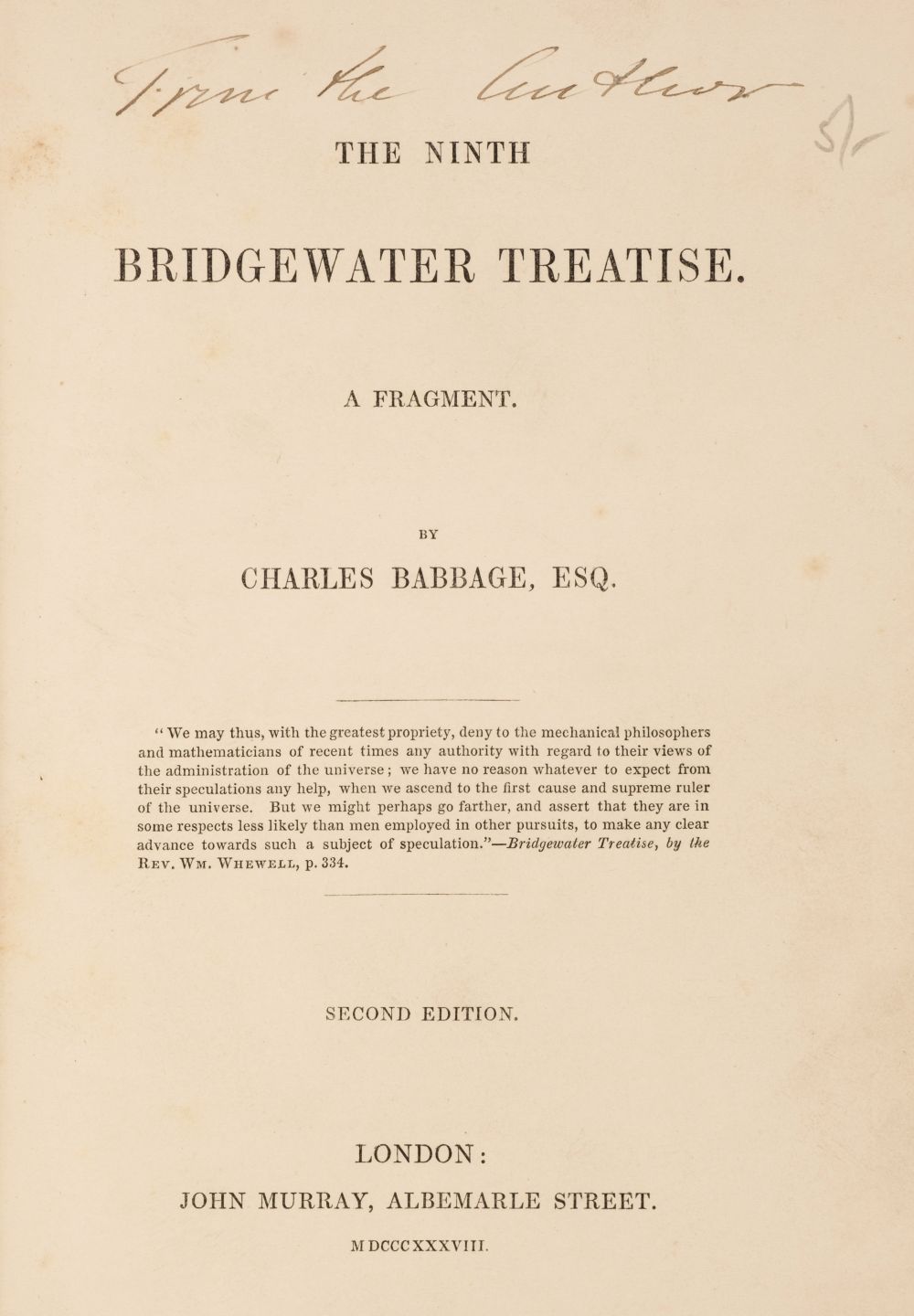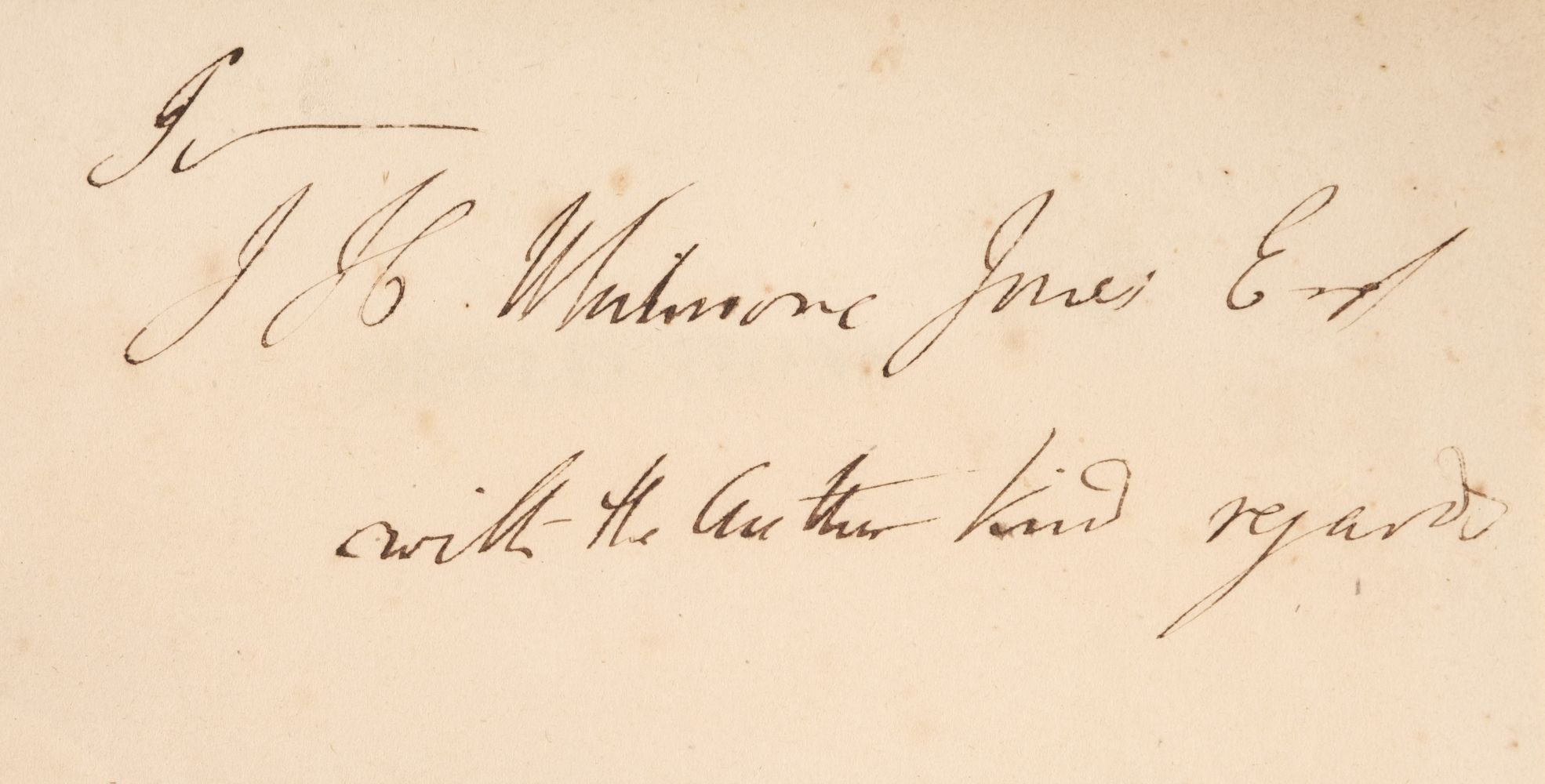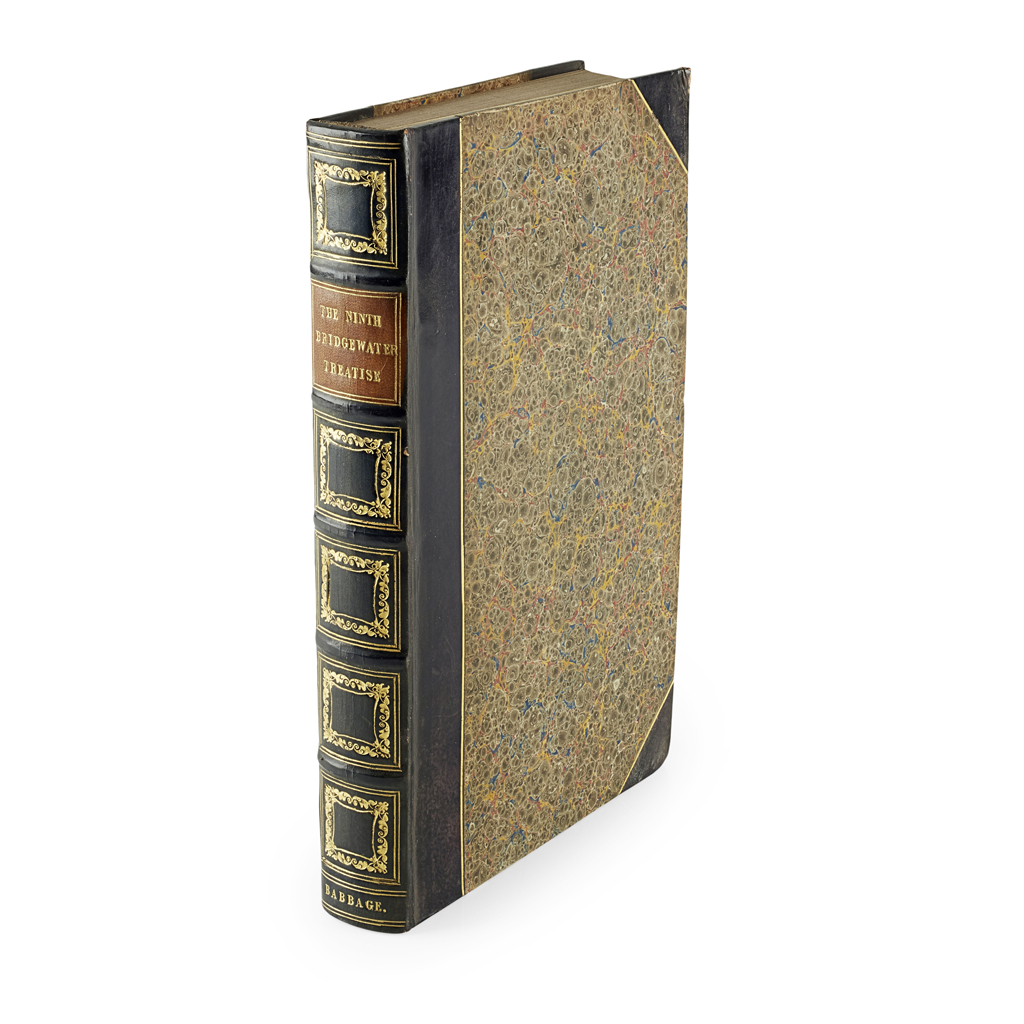BABBAGE, Charles. The Ninth Bridgewater Treatise. A fragment. London: John Murray 1837.
BABBAGE, Charles. The Ninth Bridgewater Treatise. A fragment. London: John Murray 1837. 8 o (222 x 140 mm). 2-page advertisement at end. Original black-brown cloth, paper label on spine, uncut (extremities a bit rubbed, label soiled and chipped). Provenance : Avon Book-Club (contemporary printed subscription list on front endpapers). FIRST EDITION. An unofficial continuation of the eight treatises commissioned by the President of the Royal Society and funded by the estate of the Earl of Bridgewater on the subject of "the Power, Wisdom, and Goodness of God, as manifested in Creation." Babbage's "treatise" is a rebuttal of "William Whewell's statement in the first Bridgewater Treatise ( On Astronomy and General Physics ) denying the validity of scientific attempts to explain "the administration of the universe." In it Babbage likened the Creator to a kind of master computer programmer (although this term did not exist in Babbage's time), and the operations of the universe to a gigantic program. His starting point is that of the man of science, whose work can be judged according to the degree of foresight manifest in it. Then God is a man of science and programmer writ large... The calculating engines -- and also of course a modern computer -- could easily be instructed to proceed according to one law for any number of operations and then proceed according to some other law, the change in operation being programmed ab initio . Similarly, reasoned Babbage, the changes in natural law, as evidenced by the creation of new species, were not proof of Heavenly intervention but could also have been programmed by the Creator ab initio : that is to say at the time of the Creation. In a similar manner miracles appeared as singularities in the Celestial Program: a miracle was merely a subroutine called down from the Heavenly store" (Hyman 1982, 138-39). Babbage's work also contains some significant contributions to earth history, including his system of tree-ring dating, the first scientific method proposed for this type of archeological dating. Norman 94; Van Sinderen 1980, no. 51. Origins of Cyberspace 55. [ With: ] BABBAGE, Henry P. Babbage's Calculating Engines. A Collection of Papers Relating to them; Their History, and Construction . London: E. and F.N. Spon, 1889. 2 o (294 x 226 mm). Frontispiece, additional photograph of Spitalfield's hand loom with Jaccquard, mid 20th century, bound after preface leaf, large folding general plan of Babbage's Calculating Engine, plates at end (some folding) (reinforced along folds on verso). Original cloth, gilt-lettered on front cover (rebacked and corners renewed in black cloth). Provenance : Camberwell Public Libaries (bookplate, stamps on title). Babbage left no collected edition of his writings on the calculating engine. His son, Henry P. Babbage, compiled these papers. Extensive catalogues of drawings for the Analytical Engine are printed as is the first published account of Babbage's achievement by the mathematician Menabrea and its translation into English by Babbage's enthusiastic sponsor Ada (Lady) Lovelace, the most important early paper in the history of computing. The papers discuss Babbage's Difference Engine invented in 1821 to solve the practical problem of finding a means to reliably compute the many tables needed for navigation, and his Analytical Engine, which anticipated the logical conceptions of modern digital computers. -- BABBAGE, Charles (1792-1871). "Solutions of some Problems by means of the Calculus of Functions." In: [ Journal of Science ], Volume 2, 1817]. 8 o (210 x 136 mm). 12-pp extract. (Spotted.) FIRST EDITION. Babbage's major contribution to mathematics was his calculus of functions, which he became interested in as early as 1809 and continued to develop during his years at Cambridge. Babbage presented his major ideas on the subject in two papers, published in the Philosophical Transactions in 1815 and 1816, and in the problems and solutions published here. "I
BABBAGE, Charles. The Ninth Bridgewater Treatise. A fragment. London: John Murray 1837.
BABBAGE, Charles. The Ninth Bridgewater Treatise. A fragment. London: John Murray 1837. 8 o (222 x 140 mm). 2-page advertisement at end. Original black-brown cloth, paper label on spine, uncut (extremities a bit rubbed, label soiled and chipped). Provenance : Avon Book-Club (contemporary printed subscription list on front endpapers). FIRST EDITION. An unofficial continuation of the eight treatises commissioned by the President of the Royal Society and funded by the estate of the Earl of Bridgewater on the subject of "the Power, Wisdom, and Goodness of God, as manifested in Creation." Babbage's "treatise" is a rebuttal of "William Whewell's statement in the first Bridgewater Treatise ( On Astronomy and General Physics ) denying the validity of scientific attempts to explain "the administration of the universe." In it Babbage likened the Creator to a kind of master computer programmer (although this term did not exist in Babbage's time), and the operations of the universe to a gigantic program. His starting point is that of the man of science, whose work can be judged according to the degree of foresight manifest in it. Then God is a man of science and programmer writ large... The calculating engines -- and also of course a modern computer -- could easily be instructed to proceed according to one law for any number of operations and then proceed according to some other law, the change in operation being programmed ab initio . Similarly, reasoned Babbage, the changes in natural law, as evidenced by the creation of new species, were not proof of Heavenly intervention but could also have been programmed by the Creator ab initio : that is to say at the time of the Creation. In a similar manner miracles appeared as singularities in the Celestial Program: a miracle was merely a subroutine called down from the Heavenly store" (Hyman 1982, 138-39). Babbage's work also contains some significant contributions to earth history, including his system of tree-ring dating, the first scientific method proposed for this type of archeological dating. Norman 94; Van Sinderen 1980, no. 51. Origins of Cyberspace 55. [ With: ] BABBAGE, Henry P. Babbage's Calculating Engines. A Collection of Papers Relating to them; Their History, and Construction . London: E. and F.N. Spon, 1889. 2 o (294 x 226 mm). Frontispiece, additional photograph of Spitalfield's hand loom with Jaccquard, mid 20th century, bound after preface leaf, large folding general plan of Babbage's Calculating Engine, plates at end (some folding) (reinforced along folds on verso). Original cloth, gilt-lettered on front cover (rebacked and corners renewed in black cloth). Provenance : Camberwell Public Libaries (bookplate, stamps on title). Babbage left no collected edition of his writings on the calculating engine. His son, Henry P. Babbage, compiled these papers. Extensive catalogues of drawings for the Analytical Engine are printed as is the first published account of Babbage's achievement by the mathematician Menabrea and its translation into English by Babbage's enthusiastic sponsor Ada (Lady) Lovelace, the most important early paper in the history of computing. The papers discuss Babbage's Difference Engine invented in 1821 to solve the practical problem of finding a means to reliably compute the many tables needed for navigation, and his Analytical Engine, which anticipated the logical conceptions of modern digital computers. -- BABBAGE, Charles (1792-1871). "Solutions of some Problems by means of the Calculus of Functions." In: [ Journal of Science ], Volume 2, 1817]. 8 o (210 x 136 mm). 12-pp extract. (Spotted.) FIRST EDITION. Babbage's major contribution to mathematics was his calculus of functions, which he became interested in as early as 1809 and continued to develop during his years at Cambridge. Babbage presented his major ideas on the subject in two papers, published in the Philosophical Transactions in 1815 and 1816, and in the problems and solutions published here. "I










Testen Sie LotSearch und seine Premium-Features 7 Tage - ohne Kosten!
Lassen Sie sich automatisch über neue Objekte in kommenden Auktionen benachrichtigen.
Suchauftrag anlegen